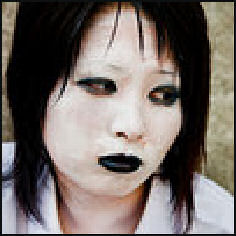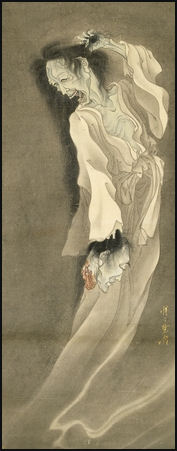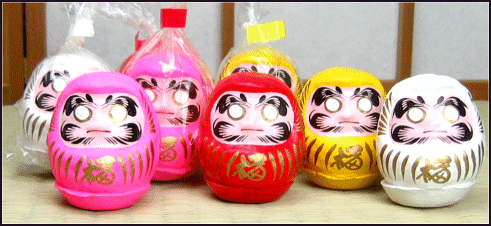JAPANESE GHOSTS

cosplay ghost Folklore experts have suggested that the belief in ghosts has a stronger influence on the lives of Japanese than of Westerners. There are 100 designated haunted sites in Tokyo alone. Ghosts often pop in police dramas and murder mysteries and office ladies stories on television. [Source: Mark Magnier, Los Angeles Times, May 20, 2002]
Ghosts are associated most with summer time, especially in mid-August when Japanese visit the graves of their elders during the Bon Festival. Children believe they hang out in wet of damp area like the toilet or bath. Adults believe they show up during times of uncertainty.
Japanese have traditionally believed that when people die their souls travel to another world but before they do they survive as ghost between the two worlds. According to Japanese folk beliefs ghosts are the spirits of dead people who died in great pain if with strong feeling of bitterness or regret and are unable move in to the next life. They typically have lim wrists, disheveled hair and are often formless from the knees down, They return to Earth to haunt people and places they knew when they were alive. [Source: Kevin Short, Yomiuri Shimbun]
Most Japanese ghost fall into two categories: 1) “yurei”, human form ghosts regarded as angry and whimsical; and 2) “yokai”, half-human and half-animal playful creatures associated mostly with places (See Yokai Above). Yurei are seen by many as dead humans whose soul was not appeased before they left the earth and come back for vengeance.
There is a whole genre of ghost paintings, many of them inspired by specific ghost stories such as Utagawa Kunitoshi’s “ Ghost of Koheiji Kobata “, about a bald-headed, google kabuki actor drowned by his wife’s lover who returned every night to leer at the couple as they make lobe under a mosquito net.
Book: “Ghosts and the Japanese Cultural Experience in Japanese Death Legends” by Michiko Iwasaka and Barre Toelken
History of Ghosts in Japan

In the old days ghosts were regarded as benign and were closely associated with ancestor worship, kamis and Shintoism. After the introduction of Buddhism in the 6th century these beliefs became regarded as primitive and ghost began to take on a more sinister character and as forces of evil opposing the positive forces of Buddhism.
In the 12th century ghost were blamed for social problems. In the 17th century they lost their legs, a change linked to kabuki, whose actors’ legs are hidden beneath their kimonos.
In 2003, a 54-year-old man confessed he killed a man, previously thought to have committed suicide, in 1980 to see if the dead’s man spirit would come back to haunt him. “Since there’s a saying that a murdered person will become a ghost and haunt his or her killer, I wanted to see whether it was true,” he said.
Famous Japanese Ghosts
Masakado Taira, a samurai who died in A.D. 940 in a bloody power struggle, is one Japan’s most well known ghosts. He was blamed for a samurai uprising in 1872 that was only quelled after a visit by the Emperor to his former residence. Plans to erect a building or memorial site were scrubbed after a minister and 13 senior officials died under mysterious circumstances. On the 1000th anniversary of his death lighting struck the nearby Ministry of Finance and burned it to the ground. The Long Term Credit bank collapsed in 1998 after it sold the land under the shrine.
Today, Taira has a shrine in the financial district of Tokyo that is visited everyday by salarymen and housewives who leave food, presents and money. He is so popular he even has his own bank account, with around $200,000 in it.
Prime ministers refused to live in their official residence for two decades because it said to be haunted from a bloody coup attempt in 1932. People have reported seeing strange figures drifting around the courtyards of the residence. In the year 2000, Prime Minister Yoshiro Mori said he saw door handles moving by themselves and heard strange crawling noises in the house.
Japanese Ghost Stories
Ghost stories are associated with the summer time, especially around the Bon Festival when Japanese pay their respects to their ancestors. They are often featured in the stories told by rakugo comic storytellers and depicted in silk paintings. During the Edo period there was a ban on the telling of ghost stories even though ghosts were reproduced through woodblock printing and widely sold as cards.
Many ghost stories revolve around ghosts who have to return to the world of the living to take care of some unfinished business or seek the repayment of a moral debt. The Japanese concept of “on”, loosely translated as obligation, lies at the heart of many ghost stories. Unfulfilled on is an unnerving thing if it involves someone who is dead.
In his book on ghosts Japanologist Lafcadio Hearns wrote about a stone turtle at Gesshoji temple in Matsue that came to life at night and devoured people and female a ghost at Daioji temple in the same town that gave birth to a baby in a grave and then went out to buy candy for it.

famous Utagawa ukiyo-e
Famous Ghost Stories in Japan
One favorite ghost story “Bancho Sarayashiki” is about a maid named Okiku who is employed by an evil samurai to take care of ten precious plates, She is told no matter what to never let anything happen to the plates. One day one of the plates is broken or stolen — there are many variations of the story — and Okiku is blamed and killed and thrown down a well by the samurai. Okiku’s soul can no rest, being killed so unjustly, and her spirit returns to Earth as a ghost , repeatedly counting the plates and coming up with one missing.
A famous ghost story called “Botandoro” (“The Peony Lantern”) is about a man and women involved in love affair. The man becomes ill and is unable to ses his lover. When he recovers and visits her he finds that she has died. The lover’s ghost visits him and eventually he dies embracing her skeleton.
“No Mononoke Roku” (“Ino Ghost Story”) is about a 16-year-old youth named Ino Heitrai who saw ghosts — including a giant one-eyed man, a woman with her head on upside down, an earthworm ghost and monstrous frog — every night for 30 days. The story was made into a popular anime called “Asagiri no Miko” (“Shrine Maiden in the Morning Mist”).
Ghost Investigations in Japan
In 1999, residents of a "haunted" 24-unit complex in the town of Tomika (180 miles southwest of Tokyo) reported hearing strange noise like whoops and pounding fists and told stories about dishes crashing down for no reason and electric appliances that started by themselves. An 11-year-old girl claimed she was touched by someone who wasn't there and three residents claimed they saw a ghostly woman dressed in an old-style kimono. [Source: Hideko Takayama, Newsweek, November 6, 2000]
Rumors began circulating that an unhappy housewife had hung herself on a nearby tree. The residents called in local officials to investigate and they hired a Shinto ascetic who scattered offerings of fruit and squid and declared an "unfortunate death had occurred here."
Soon afterwards tourists, tabloid journalists and amateur psychics began descending on the town. Camera crews took turns occupying one apartment around the clock, waiting for something to happen. Nothing much did. One man walked around with bag and tried to get the ghost to enter so he could analyze it. One tabloid photographed a sexy teenage psychic in a miniskirt as she looked for clues.
Psychics from all over Japan were asked for their help. One who said he would do the job for $160,000 was sent packing right away. Another who only charged $400 had to give a refund when his remedies didn’t work. Finally the ghost were dispelled to the satisfaction of the residents by a woman and 15 monks who spent three days chanting non stop.

daruma dolls
Exorcisms in Japan
Shinto priests perform exorcism rituals for houses, cars and businesses that in involve chanting a few words and shaking pom poms with dangling white paper (See Shinto rituals). Some physics perform exorcisms over the Internet.
In 1995, police found the decomposing bodies of two men and four women stuffed into futons in the house of a 47-year-old faith healer named Sachiko Eto. The victims were followers of Eto who died during an exorcism intended to rid the victims of evil spirits, in which the participants beat each other with drum sticks and were beaten by Eto and two others. One other person who endured the beatings was seriously injured but survived.
Eto claimed to be god’s messengers and condemned the followers tod death and was able to carry out the death because of her absolute power over them The police investigated the house after a woman reported she was beaten there and she disappeared. Neighbors said that Eto appeared to be an ordinary housewife even though sometimes strange drumming noises, screams and odors emanated from her house.
In May 2002, Eto was sentenced to death for murder for killing four of the people and inflicting injuries that caused the death of two others. The court rejected her insanity plea. Three of Eto’s followers were given prison sentences for their role in the crime. In 2008 the Japanese Supreme Court upheld the death sentence.
Image Sources: 1) cat, fox, daruma dolls, Goods from Japan, 2) Seven gods drawings, yokai JNTO3) 4) seven gods photo, Ray Kinnane, 5) ghost, merman and skeleton ukiyo-e, British Museum, 6) cosplay ghost Andrew Gray, Photosensibility7) UFO noodles exorsystblog
Text Sources: New York Times, Washington Post, Los Angeles Times, Daily Yomiuri, Times of London, Japan National Tourist Organization (JNTO), National Geographic, The New Yorker, Time, Newsweek, Reuters, AP, Lonely Planet Guides, Compton’s Encyclopedia and various books and other publications.
Last updated July 2011
